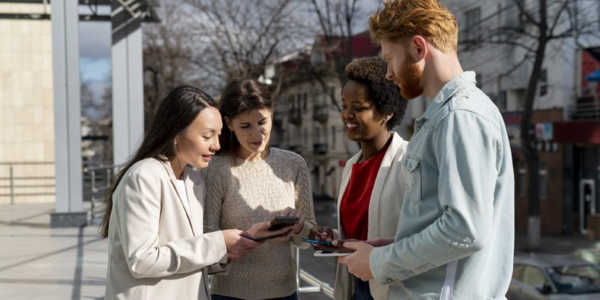Hybrid socializing has become a significant part of modern life, blending the digital and physical worlds. This merging of online and in-person interactions has shaped how people build relationships, stay connected, and engage. As technology continues to evolve, understanding how to balance these two aspects of social life is crucial for maintaining healthy, meaningful connections.
The Rise Of Hybrid Socializing: Bridging The Gap Between Digital And Physical Interaction
Hybrid socializing blends digital and in-person interactions. This trend gained momentum during the global pandemic when online platforms like Zoom and social media became vital for maintaining connections. As restrictions eased, people continued to combine virtual and face-to-face engagements. This method provides flexibility and convenience, enabling people to maintain connections with loved ones over long distances while preserving face-to-face interactions. Hybrid socializing bridges gaps and provides a balanced communication method in today's increasingly digital world.
A New Way Of Building Connections
Hybrid socializing has redefined relationships by blending online and in-person interactions. Once seen as secondary, online communication is now widely accepted, allowing friendships to flourish across distances. The flexibility to alternate between digital and physical engagements has expanded social circles, offering greater social adaptability.

The Benefits And Challenges Of Balancing Online And In-Person Connections
Balancing online and in-person connections is critical in modern social life. Digital communication offers convenience alongside the emotional depth of face-to-face interactions, but it also presents challenges.
The Convenience Of Online Interaction
Hybrid socializing offers convenience by enabling communication anytime, anywhere, through digital platforms. It allows people with busy schedules to maintain relationships. It helps introverted or socially anxious individuals engage at their own pace, creating a less overwhelming environment for meaningful connections and diverse social experiences.

The Value Of Face-To-Face Interaction
Conversely, in-person interactions remain essential for forming deeper emotional bonds. Studies consistently show that face-to-face communication strengthens trust, emotional connection, and satisfaction. Physical presence, the subtleties of body language, and the spontaneity of real-time interaction are aspects of socializing that cannot be fully replicated online.
Balancing these two forms of engagement is critical. While digital platforms offer convenience, relying solely on them may weaken relationships over time. Face-to-face interactions are necessary to maintain a sense of authenticity and deepen emotional ties.
Challenges Of Hybrid Socializing
Despite its benefits, hybrid socializing also presents challenges. One of the most significant is the potential for social burnout. Switching between online and in-person engagements can lead to overstimulation, where individuals feel pressured to stay connected in both worlds. Constant notifications, video calls, and invitations to physical events can result in feelings of being spread too thin, leaving little room for personal downtime.
Another challenge is the blurred boundary between online and offline lives. Socializing online often creates a sense of immediacy, where people must respond quickly to messages or participate in activities, even when they would prefer not to. This pressure can contribute to stress and anxiety.
Additionally, there is the risk of superficial connections. While digital platforms make it easier to stay in touch, the quality of interactions may suffer. Online communication, often limited to short messages or video calls, can need more depth of face-to-face conversations. Over time, this can lead to weaker relationships, where individuals feel less emotionally connected.

How Technology Shapes The Future Of Social Engagement
Technology continues to evolve and play a critical role in shaping how people socialize. From virtual reality (VR) environments to artificial intelligence (AI) driven social platforms, the future of hybrid socializing is filled with possibilities.
Virtual Reality And Social Spaces
Virtual reality transforms social interactions by offering immersive experiences that blend online and in-person engagement. Through avatars, people can interact in virtual environments, engaging in activities and exploring spaces together. VR provides a sense of presence and connection beyond traditional video calls or messaging apps. In the future, hybrid socializing may involve attending virtual events or simply chatting with friends in VR, further blurring the line between the digital and physical worlds.
AI And Social Platforms
Artificial intelligence is also shaping hybrid socializing. AI-driven platforms can now analyze social interactions, provide personalized recommendations for social activities, suggest friends, or curate content tailored to an individual's preferences. Though this may enrich social interactions, it also prompts concerns about the influence of algorithms on human connections.

As AI becomes more integrated into social platforms, it has the potential to assist in managing social burnout. For example, AI could help users strike a balance between their online and offline lives by analyzing patterns and suggesting breaks when needed.
Tips For Creating A Healthy Balance In Hybrid Socializing
Achieving a balance between online and in-person socializing requires mindfulness and intentionality. While hybrid socializing offers flexibility, managing time and energy to avoid burnout and maintain meaningful connections is essential.
Prioritize Face-To-Face Time
While online interactions are convenient, make a conscious effort to prioritize in-person meetings when possible. This strengthens relationships and provides emotional fulfilment that digital interactions cannot fully replace. Schedule regular meetups with close friends or family to maintain that personal connection.
Set Boundaries For Online Engagement
With the constant stream of notifications and messages from various platforms, setting boundaries for online socializing is crucial. Designate times for checking social media or responding to messages, and permit yourself to disconnect when needed. This will help prevent digital fatigue and ensure that online interactions remain meaningful rather than draining.
Balance Social Time With Personal Time
It's easy to feel obligated to attend every social event, whether online or in person. However, balancing social activities with personal downtime is critical to avoiding burnout. Make sure to carve out time for self-care and relaxation, allowing yourself to recharge between social engagements.

Conclusion
Hybrid socializing reflects how the modern world has evolved, blending the convenience of online interactions with the emotional depth of face-to-face connections. While this new form of socializing offers numerous benefits, it also presents challenges that require mindfulness and balance.
Individuals can enjoy the best of both worlds by setting boundaries, prioritizing personal time, and making space for in-person engagements. As technology continues to shape the future of social interaction, finding the right balance will remain essential to maintaining meaningful, fulfilling relationships in an increasingly connected world.








